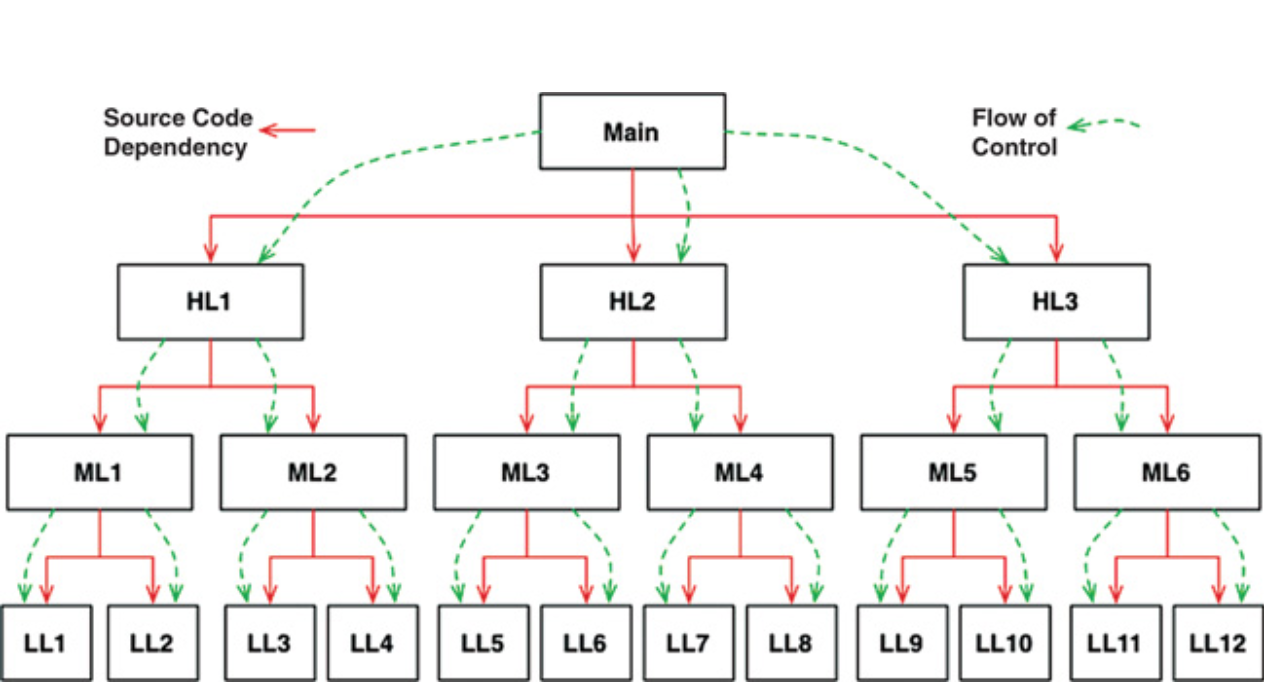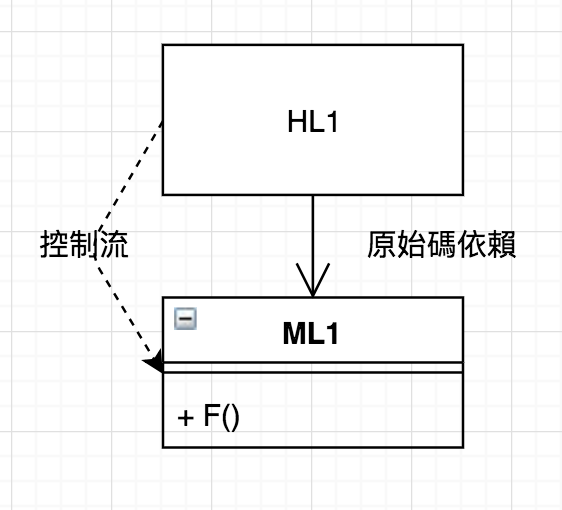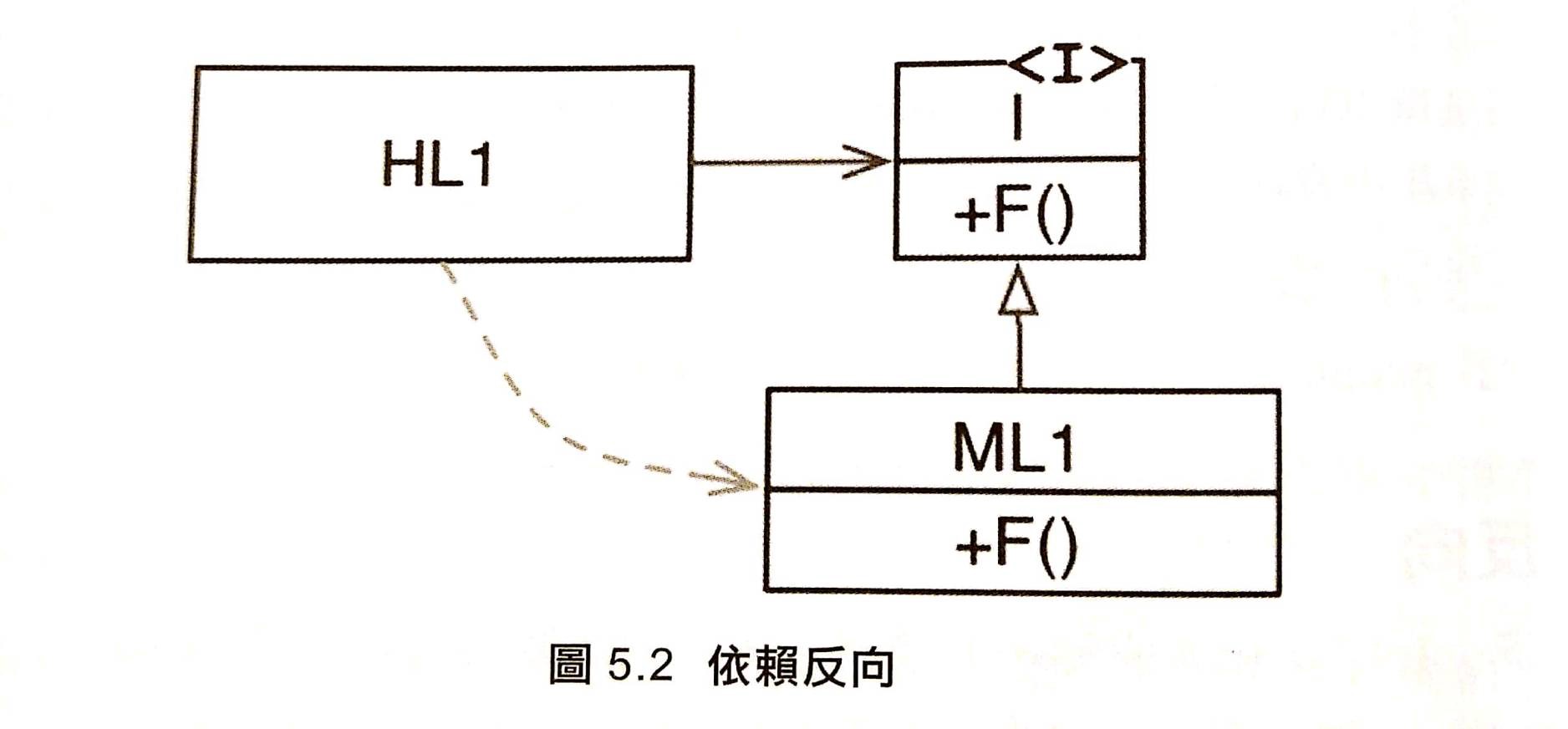Ch5: 物件導向程式設計
定義
物件導向程式設計是透過多型,來獲得每個系統中的程式碼依賴方向有絕對控制力
常見的物件導向的定義誤區
我認為他想說的:
這些定義在 OO 裡面的確有出現(也很常見),但是並不是讓他定義成為 OO 最主要的原因,在其他非OO的地方也能實作出來。
資料和函式的結合?
- 這意味著 object.function() 和 function(object) 有不一樣
- Dahl 與 Nygaard 將 function 呼叫堆疊框架一到了 heap,並發明了 OO
// object.function()
class Greeting {
private message: string
constructor(message: string) {
this.message = message
}
hello() {
console.log(this.message)
}
}
const greeting = new Greeting('hello')
greeting.hello()// function(object)
const messages = {
hello: 'hello',
}
function greeting(messages: { hello: string }) {
const message = messages.hello
console.log(message)
}
greeting(messages)一種模擬真實世界的方式?
- 定義太過鬆散,還是沒有說明什麼是 OO
三種本質定義?:
原文在這裡都是用 C 語言做舉例
- 封裝 (encapsulation)
- 繼承 (inheritance)
- 多型 (polymorphism)
封裝
在 C 語言中使用
structure反而可以將資料完美封裝,
而到了 C++反而某種程度被破壞
C 語言:
point.h 的使用者可以呼叫
makePoint()和distance(), 但是他們完全不知道 Point 的資料結構和 function 的實作
// point.h
struct Point;
struct Point* makePoint(double x, double y);
// point.c
// define the details
#include "point.h"
#include <stdlib.h>
#include <math.h>
struct Point {
double x, y;
}
struct Point* makePoint(double x, double y) {
//......
}
double distance(struct Point* p1, struct Point* p2) {
// ...
}
C++ 語言:
因為編譯器在技術上需要查看這些在標頭檔裡的變數,
所以 point.h 的使用者知道成員變數 x, y 的相關資訊,
雖然在後續的public,private,protected等關鍵字修復
但是這只是一種 hack 手法,在後續其他語言更弱化了封裝。
// point.h
class Point {
public:
Point(double x, double y);
double distance(const Point & p) const;
private:
double x;
double y;
};
// point.cc
#include "point.h"
#include <math.h>
Point::Point(double x, double y): x(x), y(y) {}
doublePoint::distance(const Point& p) const {
//....
}
繼承
- 在 OO 語言之前就有了一種繼承(宣告一模一樣的資料結構,並延伸),
但是是使用一種欺騙的方式實作,不如真正的繼承使用方便。- 這種使用方式要實現多重繼承是非常困難的。
- OO 語言在繼承方面雖然沒有帶來新東西,但是使用上更方便。
C 語言:
// point.h
struct Point;
struct Point* makePoint(double x, double y);
// namedPoint.h
struct NamedPoint;
struct NamedPoint* makeNamedPoint(double x, double y, char* name);
void setName(struct NamedPoint* np, char* name);
char* getName(struct NamedPoint* np);
- 在範例中,第二個程式的資料結構前兩個欄位的順序與上一個 Point 相同,
所以可以偽裝成 Point,因為 NamedPoint 是 Point 的一個純超集合,並維護對應成員順序。 - 在多重繼承的時候,就得不斷把成員往上加.....
以 JS 說明使用 OO 繼承更為方便:
// point.ts
class Point {
private x: number;
private y: number;
constructor(x: number, y: number) {
this.x = x
this.y = y
}
}
// namedPoint.ts
import Point from 'path/to/point.ts'
class NamedPoint extends Point {
private name: string
constructor(name: string) {
super()
this.name = name
}
setName() {
//...
}
getName() {
//...
}
}
多型
- 在早期 C 語言必須用函式指標來實現多型的行為,這依賴一系列約定, 工程師必須透過指標呼叫函示,如果有人沒遵守,產生的 bug 會很難追查和消除。 所以指向函式的指標很是危險的。
- 雖然 OO 沒有帶來多型,但是使得多型更安全和方便。
- 作者認為最有威力和代表性。
- 可以使用interface 或是 abstract class來實現,目的是解耦兩個物件。
介面(Interface) vs 抽象類別(Abstract Class)
介面:
- interface 規範了外部使用的規則,不管詳細的實現方式,而是交由類別來實作。
- 不同的類別可以有完全不同的實作細節。
- interface 描述了外部能夠使用的變數或方法,所以在後續寫類別時,
可以避免暴露了不該暴露的變數或函式。 - 介面不一定是要能被重複使用。
- 當介面改變時,相對應的類別要需要做相對應修正,以確保符合一致的規範。
// interface
// 兩個類別實作相同介面
interface USB {
execute(): void
stop(): void
}
class Mouse implements USB {
private state: string
private countClick: number
constructor(state: string, countClick: number) {
this.state = state
this.countClick = countClick
}
public execute() {
this.state = 'mouse start'
}
public stop() {
this.state = 'mouse stop'
}
private countClicking() {
this.countClick += 1
}
}
class Keyboard implements USB {
private state: string
constructor(state: string) {
this.state = state
}
public execute() {
this.state = 'keyboard start'
}
public stop() {
this.state = 'keyboard stop'
}
//....
}
抽象類別:
- 抽象類別不能實例化,每一個實例都是具體子類別的實例。
- 抽象類別不止可以實現抽象方法,更可以包含商業邏輯與私人屬性。
// abstract class
abstract class Animal {
private weight: number
constructor(weight: number) {
this.weight = weight
}
abstract walk(): void
abstract sleep(): void
}
class People extends Animal {
constructor(weight: number) {
super(weight)
}
walk() {
console.log('people walking...')
}
sleep() {
console.log('people sleeping...')
}
}
class Dog extends Animal {
constructor(weight: number) {
super(weight)
}
walk() {
console.log('Dog walking...')
}
sleep() {
console.log('Dog sleeping...')
}
}
- interface 比較著在重描述互相沒有關聯的類別,所共通的方法和類別。
- abstract class 描述共同得物件屬性,比較多件層關係 (如:動物(比較抽象) => 人(比較具體))
- 兩個結合在一起使用
// more example of compose abstract and interface...
abstract class Machine {
public battery: number
constructor(battery: number) {
this.battery = battery
}
abstract boost(): void
abstract shutDown(): void
}
abstract class Vehicle {
public abstract start(): void
public abstract turn(): void
}
// 有共用的USB功能,但是不能被繼承。
interface USB {
execute(): void
stop(): void
}
class Computer extends Machine implements USB {
boost() {
console.log('computer Boosting...')
}
shutDown() {
console.log('computer shutdown....')
}
execute() {
console.log('computer USB executing....')
}
stop() {
console.log('computer USB stopping....')
}
}
class Car extends Vehicle implements USB {
start() {
console.log('Car starting....')
}
turn() {
console.log('Car turning.....')
}
execute() {
console.log('Car USB executing....')
}
stop() {
console.log('Car USB stopping....')
}
}
多型的威力 - 依賴反向
原本程的依賴性只能依照控制流來決定,而多型能夠讓依賴反轉。

如果沒有多型

// 如果沒有多型
class Computer {
execute() {
console.log('computer USB executing....')
}
stop() {
console.log('computer USB stopping....')
}
}
class Car {
execute() {
console.log('Car USB executing....')
}
stop() {
console.log('Car USB stopping....')
}
}
const computer = new Computer()
const car = new Car()
computer.execute()
car.execute()
// [LOG]: "computer USB executing...."
// [LOG]: "car USB executing...."
如果有多型實現依賴反向

- 加入 interface 實現反向依賴
interface USB {
execute(): void
stop(): void
}
class Computer implements USB {
execute() {
console.log('computer USB executing....')
}
stop() {
console.log('computer USB stopping....')
}
}
class Car implements USB {
execute() {
console.log('Car USB executing....')
}
stop() {
console.log('Car USB stopping....')
}
}
function executeTheUSB(usb: USB) {
usb.execute()
}
executeTheUSB(new Computer())
executeTheUSB(new Car())
// [LOG]: "computer USB executing...."
// [LOG]: "car USB executing...."
- 加入 abstract class 實現反向依賴
// more example using abstract class...
abstract class Animal {
public name: string
constructor(name: string) {
this.name = name
}
}
class Dog extends Animal {
constructor(name: string) {
super(name)
}
sleep() {
//...
}
}
class People extends Animal {
constructor(name: string) {
super(name)
}
walk() {
//...
}
}
function speakMyName(animal: Animal) {
console.log('my name is: ' + animal.name)
}
speakMyName(new Dog('小白'))
speakMyName(new Dog('彼得'))
// [LOG]: "my name is: 小白"
// [LOG]: "my name is: 彼得"
依賴反轉的優勢
business rules 將不會有任何 UI 或資料庫程式

因為模組之間不是只有單向的依賴關係,可以使模組之間更加獨立已達到:
- 可獨立性部署
- 可獨立性開發